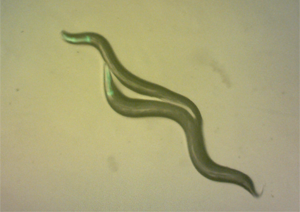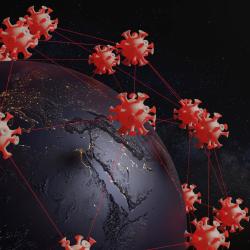Worm Species Lost 7,000 Genes After Evolving to Fertilize Itself
Reproduction in most animal species requires breeding between two individuals. But some worms have evolved the ability to go it alone. In these species, a single individual can breed with itself to produce offspring.

A new University of Maryland-led study found that gaining this ability, known as “selfing,” may have caused a worm species to lose a quarter of its genome, including genes that give male sperm a competitive edge during mating.
“Our results suggest that genes that are essential for tens of millions of years can suddenly become useless or liabilities, even, when the sex system changes,” said Eric Haag, a professor of biology at UMD and lead investigator of the study, which was published in the journal Science on January 5, 2018.
A million years ago, a species of tiny worms called Caenorhabditis briggsae evolved the ability to breed via selfing. As a result, most C. briggsae are hermaphrodites with both male and female sex organs. Haag’s group, which focuses on the evolution of sex, has long studied C. briggsae because of their unusual reproductive behavior.
To study how selfing shaped the evolution of C. briggsae, Erich Schwarz, an assistant research professor of molecular biology and genetics at Cornell University and co-corresponding author of the study, sequenced the genome of Caenorhabditis nigoni, the closest relative of C. briggsae. C. nigoni always reproduce by mating with other individuals, or outcrossing. By comparing the genomes of the two species, the researchers found that the selfing C. briggsae worms had 7,000 fewer genes than C. nigoni. Over time, C. briggsae lost approximately a quarter of its genome.
Because the two worms differ primarily in their method of reproduction, the researchers hypothesized that the shift from outcrossing to selfing led to the gene loss. To confirm this, they compared gene activity in C. nigoni males and females and found that almost three-quarters of the genes that C. briggsae lost were more active in C. nigoni males than females.
Seeking possible sex-related functions for the lost genes, the researchers focused on a family of “male secreted short” (mss) genes that C. nigoni had but C. briggsae did not have. In fact, no known selfing Caenorhabditis species have mss genes. And mss genes are only active in the male worms of outcrossing species, according to previous research conducted by Haag, Schwarz, former UMD graduate student Cristel Thomas (Ph.D. ’11, molecular and cellular biology) and former UMD undergraduate student Rebecca Felde (B.S. ’13, biological sciences).
Using a gene-editing tool called CRISPR, the researchers removed four mss genes from an outcrossing species, Caenorhabditis remanei. As a result, sperm from male C. remanei worms lacking the proteins the mss genes encode could not compete against sperm from wild-type C. remanei males with the genes. Conversely, when the researchers inserted mss genes into male C. briggsae worms, their sperm outcompeted sperm from wild-type C. briggsae males and from wild-type C. briggsae hermaphrodites.
The researchers also found that the mss genes encode short proteins that coat the surface of sperm cells. Taken together, the results suggest that the mss genes give the sperm of male worms a competitive edge during mating.
“The fact that all the selfing species lost the mss genes suggests that these genes, which are very useful for worms having male-female sex, are harmful for worms that are no longer having sex with each other,” Haag said. “What we are seeing is an evolutionary snapshot of how a species fine-tunes its reproduction.”
The selfing species of worms may have lost the mss genes because having competitive male sperm is harmful, according to Haag. During the study, the researchers discovered that having more competitive male sperm changed the species’ sex ratio towards greater production of males. This shift could put the worms’ survival at risk because having too many males slows population growth, and in the wild the worms must reproduce as fast as possible to survive.
Experiments to confirm that competitive male sperm might harm C. briggsae are underway, according to Da Yin, a biological sciences graduate student in Haag’s group and first author of the study.
“We have started to compare the growth of C. briggsae populations with and without mss genes, which allows us to test whether mss genes may have been driven out of the genome of C. briggsae by selection,” Yin said. “Our hypothesis is that C. briggsae populations with mss genes will grow slower because of their higher number of males.”
Going forward, Haag and his collaborators also plan to investigate how mss genes help sperm compete. They also want to sift through the remaining 7,000 lost genes to discover their roles in C. briggsae.
“A very small, but important, number of genes might have very long-standing roles in male-female mating—roles that go back to the beginning of animal life, 700 million years ago,” Schwarz said.
A male and a hermaphroditic C. briggsae mating, or breeding via outcrossing. The hermaphrodite is the larger of the pair. Video: Da Yin
###
This work was performed in collaboration with the University of Toronto, the University of California, Davis, and the University of California, Berkeley.
This work was supported by the U.S. Department of Agriculture (Award No. 2010-65205-20361), the National Science Foundation/National Institute of Food and Agriculture (Award No. IOS-0923812), the National Institutes of Health (Award Nos. S10 RR029668, GM079414, AI111173 and GM030702), the National Science Foundation (Award No. IOS-1355119), the Moore Foundation (Award No. 4551), the Howard Hughes Medical Institute and Cornell University startup funds. Some materials were provided by the Caenorhabditis Genetics Center, which is funded by the National Institutes of Health Office of Research Infrastructure Programs (Award No. P40 OD010440). The content of this article does not necessarily reflect the views of the organizations.
The research paper, “Rapid genome shrinkage in a self-fertile nematode reveals sperm competition proteins,” Da Yin, Erich Schwarz, Cristel Thomas, Rebecca Felde, Ian Korf, Asher Cutter, Caitlin Schartner, Edward Ralston, Barbara Meyer and Eric Haag, was published in the journal Science on January 5, 2018.
Written by Irene Ying




